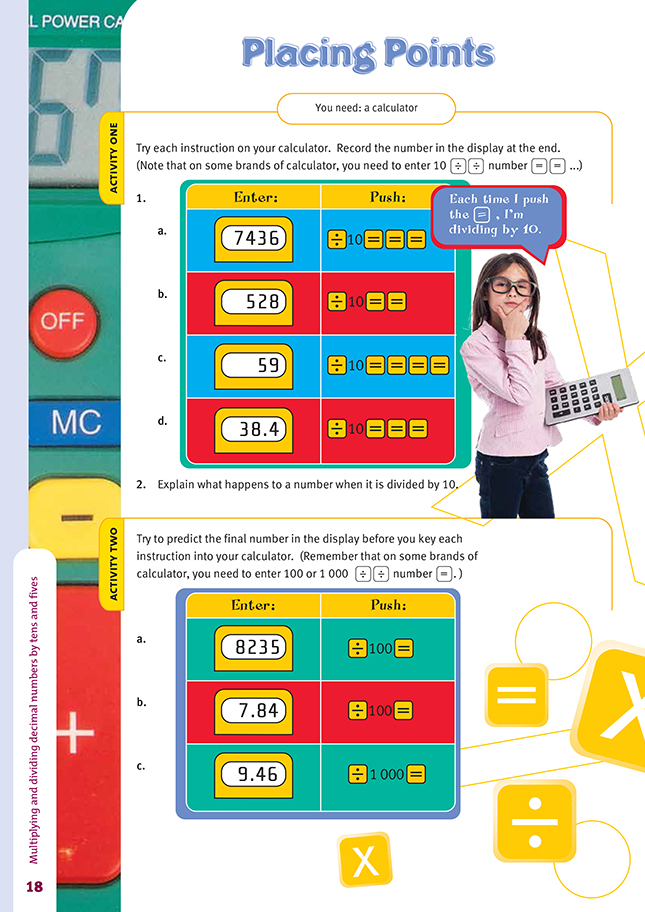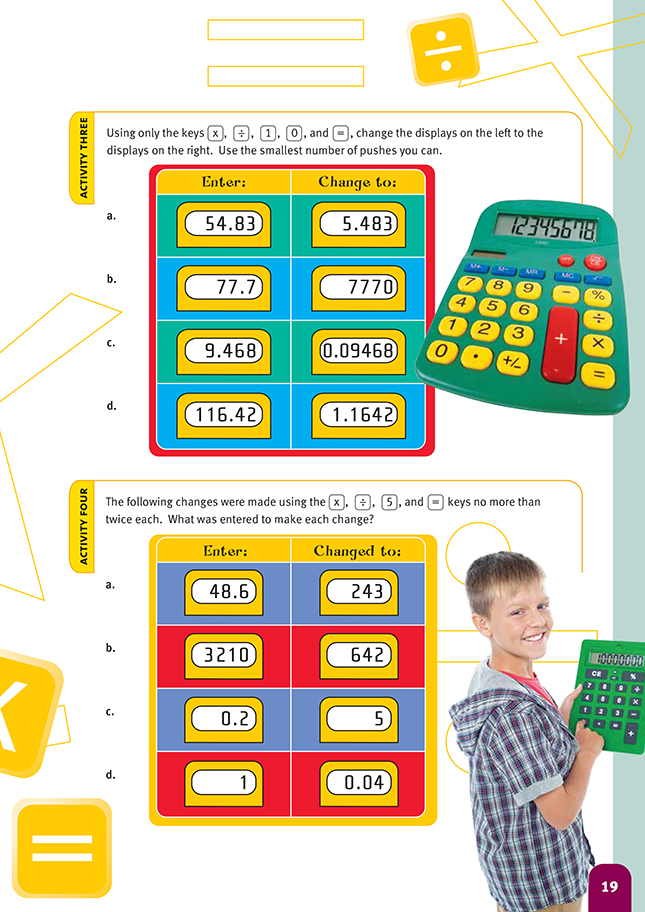This is a level 3 number link activity from the Figure It Out series. It relates to Stage 6 of the Number Framework.
A PDF of the student activity is included.
Click on the image to enlarge it. Click again to close. Download PDF (405 KB)
divide by multiples of ten
FIO, Link, Number, Book Two, Placing Points, pages 18-19
Calculator
Activities One and Two
An important learning outcome of these activities is that students understand the effect on place value of multiplying and dividing by 10 and multiples of 10.
The students need to focus on the way the digits change place. The common rule often given to students to “move the decimal point” should not be introduced too soon as students who learn this as a rote rule don’t develop the essential nderstanding of the effect on the digits. The explanations that the students give in
question b of Activity One should indicate that they understand that:
• multiplication by 10 moves digits one place to the left
• division by 10 moves digits one place to the right
• multiplication by 100 moves digits two places to the left
• division by 100 moves digits two places to the right.
These rules can then be extended to include 1 000 as a factor.
Activity Three
The relationship between the pairs of numbers throughout this activity and Activity Four is multiplicative. If the students look for an additive relationship, show them the difference between additive views and multiplicative views by looking at two numbers like 3 and 30. Additive thinkers will see the relationship as “27 more” while multiplicative thinkers will see it as “10 times greater”. The students who cannot understand the multiplicative view will find these activities difficult.
An interesting extension would be to allow the students to use the decimal point button on their calculator. By doing this, they would have a choice of either dividing by 0.1 or multiplying by 10. You can extend this to show the equivalence between multiplying by 0.01 and dividing by 100.
Activity Four
The students should realise from the keys given that all the relationships must involve multiples of 5.
The change in question c requires the students to multiply by 5 and then multiply by 5 again. You can help them to see the connections in this change if you rewrite the 5 as 5.0 and then compare it to 0.2. In a vertical mode, this would look like this:
5.0
0.2
They should see from this that multiplication will be needed to turn the 0.2 into the whole number, 5. The change in question d requires repeated division by 5. From the vertical form
1.00
0.04
the students should realise that the 1 will need to be divided to get the smaller changed number.
You could use the change in question c to discuss how the constant function on a calculator works. When multiplication is involved in a constant function arrangement on a calculator, the factor that is to be repeated must be entered first. To get the correct answer of 5, they would need to press 5 x 0.2 = = . (If 0.2 is entered first, 0.2 x 5 = = , they would get an answer of 0.2 because 0.2 would be the factor being
repeated.)
Answers to Activity
Activity One
1. a. 7.436
b. 5.28
c. 0.0059 (Some calculators may show this as 5.9–03)
d. 0.0384
2. The digits move one place value to the right. (You can see this very clearly on a calculator.)
Activity Two
a. 82.35
b. 0.0784
c. 0.00946 (Some calculators may show this as 9.46–03)
Activity Three
The simplest calculations would be:
a. 54.83 ÷ 10 = 5.483
b. 77.7 x 100 = 7 770
c. 9.468 ÷ 100 = 0.09468
d. 116.42 ÷ 100 = 1.1642
Activity Four
a. 48.6 x 5 = (because 48.6 x 5 = 243)
b. 3 210 ÷ 5 = (because 3 210 ÷ 5 = 642)
c. 0.2 x 5 x 5 = (because 0.2 x 5 x 5 = 5)
d. 1 ÷ 5 ÷ 5 = (because 1 ÷ 5 ÷ 5 = 0.04) or
1 ÷ 5 = = (using the constant function)

